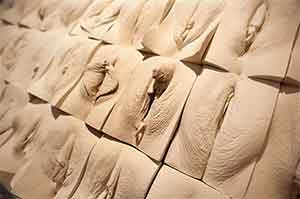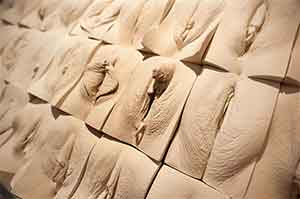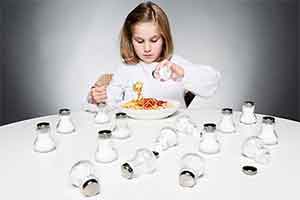Viewing images of vulva diversity could strengthen women’s genital self-image

Looking at pictures of natural vulvas in a range of shapes and sizes could help improve women’s satisfaction with their own genitalia, even those with a relatively positive genital self-image, according to new research published in the Journal of Psychosomatic Obstetrics & Gynecology.
 Many women have concerns about whether their genitals look ‘normal’. Research has shown that women’s perception of what is normal and desirable is strongly influenced by digitally and surgically modified images of female genitalia in the media, pornography, and fashion. Women’s desire to conform to this ‘norm’ is a possible reason behind the rise in demand for labiaplasty (reshaping the labia or lips) in the Western World.
Many women have concerns about whether their genitals look ‘normal’. Research has shown that women’s perception of what is normal and desirable is strongly influenced by digitally and surgically modified images of female genitalia in the media, pornography, and fashion. Women’s desire to conform to this ‘norm’ is a possible reason behind the rise in demand for labiaplasty (reshaping the labia or lips) in the Western World.
In the UK, for instance, over 2000 labiaplasties were performed on the National Health Service (NHS) in 2013, five times more than in 2008. This is likely to be just the tip of the iceberg as the vast majority of procedures are done privately.
In this study, researchers from the University of Amsterdam in the Netherlands looked at whether exposure to images depicting a variety of natural vulvas might influence women’s genital self-image. 43 female Dutch students (average age 23) were assigned to view either a series of photographs showing natural vulvas, or a series of neutral pictures of art, nature, animals, and architecture. Women rated their genital self-image before and after viewing the images and two weeks later. At the start of the study, almost two-thirds of participants reported feeling positive about their genitals.
Results showed that looking at images of natural vulvas substantially improved women’s genital self-image, regardless of their degree of sexual function, sexual distress, self-esteem, and anxiety. This was true for both women who felt negatively about their genital appearance and those with a relatively positive self-image at the start of the study. The beneficial effect was still present after two weeks. In contrast, women who viewed neutral images reported no change in their genital self-image.
“Our findings suggest that increasing awareness and education around the highly select representation of women’s genitalia in the media, as well as accurate information on the large diversity of natural, unmanipulated vulvas is very important for a positive genital self-image, and could help lessen the rising popularity of genital surgery for aesthetic reasons”, says lead author Dr Ellen Laan from the University of Amsterdam.
Because of the limited number of participants, however, further larger and longer studies will be needed involving a more representative sample of women, including those considering genital surgery, before any firm conclusions can be drawn about the effects of exposure to images revealing the diversity of the appearance of female genitalia on genital self-image.
Source: Taylor & Francis
Full bibliographic information:
Young women’s genital self-image and effects of exposure to pictures of natural vulvas; Ellen Laan, Daphne K. Martoredjo, Sara Hesselink, Nóinín Snijders & Rik H. W. van Lunsen; Journal of Psychosomatic Obstetrics & Gynecology




